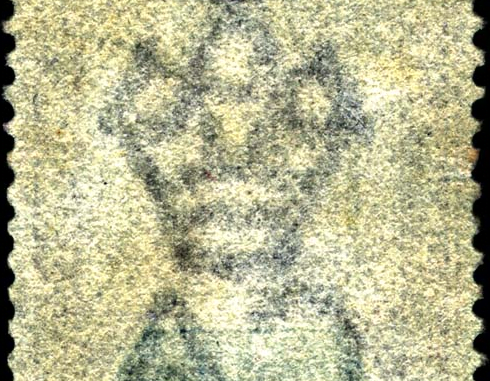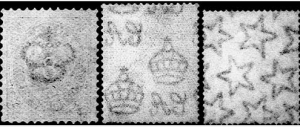
 Stamps are printed on paper which sometimes has a watermark. This watermark is created during the manufacture of the paper. A dandy roll (which is a moulded wire form) is pressed onto the moist paper. This practice was also used to prevent counterfeiting.
Stamps are printed on paper which sometimes has a watermark. This watermark is created during the manufacture of the paper. A dandy roll (which is a moulded wire form) is pressed onto the moist paper. This practice was also used to prevent counterfeiting.
The presence of watermarks on stamps may make a huge difference when identifying the stamp. For novices, finding the watermark is a huge challenge. The time spent on identifying the watermark on the stamp may be hugely rewarding. For example the Stanley Gibbons Commonwealth and British Empire Stamps (2010 edition) shows values of stamps that differ hugely depending on the watermark. One example I came across was a ½p green stamp of King George V. The value of the stamp with a watermark straight on the paper is given as £2.50, but if the watermark appears on the stamp sideways, the value is given as £18000. This is not to say that one could sell the stamp for this kind of money, but this shows how important it is to identify the watermark on the paper when identifying the stamp.
 The same stamp may show a watermark in a different position, or it may only have a part of a watermark or, as in the example above, the watermark may be upright or sideways. In many catalogues, these stamps are given different numbers and different values.
The same stamp may show a watermark in a different position, or it may only have a part of a watermark or, as in the example above, the watermark may be upright or sideways. In many catalogues, these stamps are given different numbers and different values.
As detecting watermarks is a time consuming process, you should always check which countries used watermarks on stamps and for how long. The United States, for example, only used watermarks from 1895 to 1916 whereas Great Britain has used watermarks for its entire history.
.
There are several ways to help you in identifying the watermark:
Place your stamp in a black watermark tray and cover with watermark fluid. This should enable you to identify the watermark. Some collectors use lighter fluid and experts are of the opinion that lighter fluid does not disturb the gum on the back of a stamp, however lighter fluid is toxic and can damage your health. Rather buy watermark detecting fluid available online. This seems to be the most common and most successful way of identifying watermarks. There is a trick to this process – watch out for the moment when the fluid evaporates, that is the moment you may be able to see the watermark.
If the back of the stamp is clean, you may see the watermark by holding the stamp up to the light but this is not always successful.
Watermark detectors are also available on line at a cost. The cost lies not only in purchasing the machine, but the ink sachets need replacing, and this has to be done pretty often, so cost is a real factor.
I read a post which suggests success by buying a cheap ultra violet torch and voila! You will be able to detect the watermark. Perhaps this is worth a try.
According to shaulisstamps, if you can’t find the watermark on the stamp, you should always go for the lower value in the catalogue, as stamps of high value due to different watermarks are very rare.

The subject of watermark on stamp papers is indeed an interesting one. And useful too! I enjoyed reading the advice from the end of your article, it’s good to know. Good-luck with your blog!
Hi Catalin
Thank you so much for your kind comments. Hope you enjoyed your visit to our website and we hope to hear from you again
Regards
I see three water mark images on Hong Kong stamps but ,I was looking for the number attached to each of the water marks. Can you furnish those for me .
As for your web sight it is very helpful we my stamp collecting.